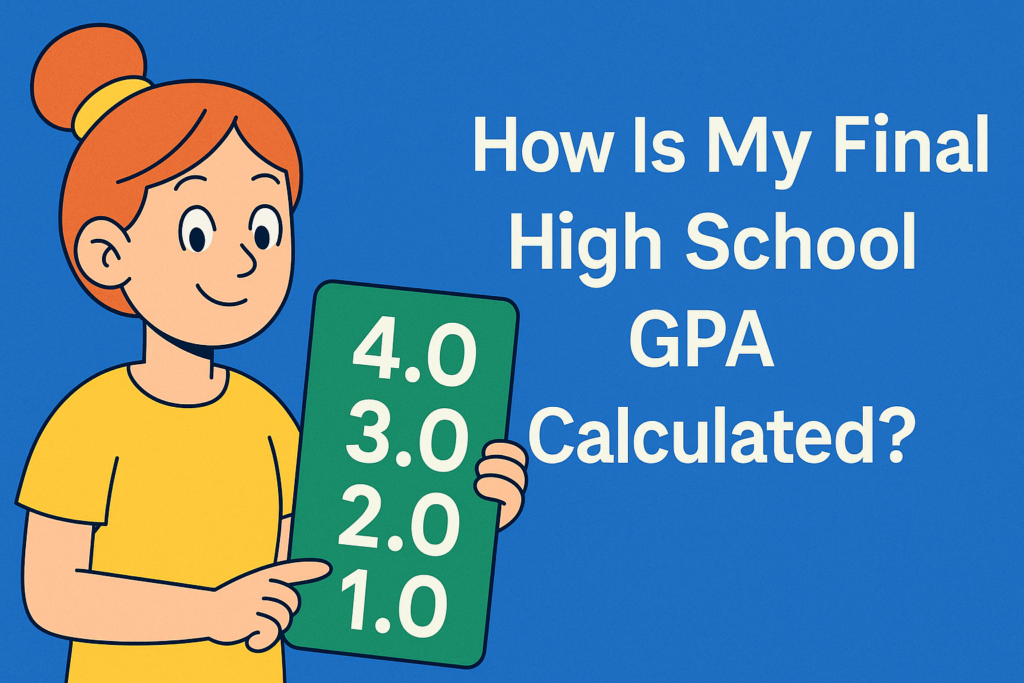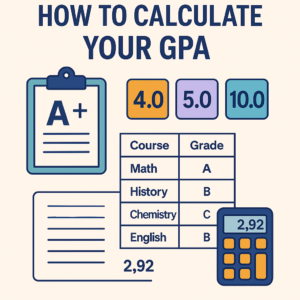
How Is My Final High School GPA Calculated?
What Is a Final GPA in High School?
Your final high school GPA is a cumulative number that reflects how you performed across all your classes from freshman through senior year. It’s more than just a semester average. It’s the total snapshot.
Colleges use this number to assess your academic readiness. Scholarships often have GPA minimums. Even some part-time jobs or internships ask for it. So yes, it’s a small number that carries weight. Not all schools calculate it exactly the same way, but the goal is to summarize your academic record into one number.
Key Components That Affect Your Final GPA
Semester Grades
Every semester counts. Each course you complete—whether in fall or spring—adds to the overall picture. Grades from early years like 9th grade may seem distant, but they’re just as included as those in 11th or 12th.
If your school uses a semester-based system, your transcript will show separate GPA scores for each term. These scores are combined to calculate your final cumulative GPA.
Course Credits
Not all classes are created equal. Some are worth more credits than others. A year-long science class might be 1 credit, while a one-semester elective might be just 0.5.
When GPA is calculated, your grade in each class is multiplied by the number of credits that class is worth. This ensures heavier classes impact your GPA more.
Course Types (Regular, Honors, AP, IB)
The difficulty level of a course can change how much GPA weight it carries. In regular classes, an A is usually worth 4.0 points. But in Honors or Advanced Placement (AP) courses, that same A can be worth 4.5 or even 5.0.
This is known as a weighted GPA. Some schools also offer International Baccalaureate (IB) programs with their own weights. Taking advanced classes can raise your GPA—but only if your grades stay strong.
GPA Scales Explained
Unweighted GPA (4.0 Scale)
An unweighted GPA doesn’t factor in course difficulty. Every A is 4.0, every B is 3.0, and so on. It treats all classes equally, which gives a clean view of how consistently you perform.
| Letter Grade | GPA Value |
|---|---|
| A | 4.0 |
| B | 3.0 |
| C | 2.0 |
| D | 1.0 |
| F | 0.0 |
Use this if your school uses unweighted reporting or if you want a standard benchmark.
Weighted GPA (5.0 Scale)
This scale adjusts for class difficulty. For example:
| Grade | Regular | Honors | AP/IB |
|---|---|---|---|
| A | 4.0 | 4.5 | 5.0 |
| B | 3.0 | 3.5 | 4.0 |
| C | 2.0 | 2.5 | 3.0 |
| D | 1.0 | 1.5 | 2.0 |
| F | 0.0 | 0.0 | 0.0 |
Weighted GPA gives extra credit to students who take more challenging courses. It’s helpful when you’re competing for admission to selective colleges.
For a quick way to check both, use our High School GPA Calculator.
Step-by-Step: How to Calculate Your Final GPA
1. Convert Grades to GPA Points
Start by turning each letter or percentage grade into a point value. Most schools use a standard table for this.
Example: A = 4.0, B+ = 3.3, C- = 1.7
2. Multiply Each Grade Point by Course Credit
If your math class is worth 1.0 credit and you earned an A (4.0), then you get 4.0 grade points. If your art class is 0.5 credits and you earned a B (3.0), that’s 1.5 grade points.
This step reflects the value of each class.
3. Add All Grade Points
Now total up the grade points you’ve earned across all classes.
Let’s say you have 20 total grade points.
4. Divide by Total Credits Taken
Divide total grade points by the total number of credits you’ve completed.
For example, 20 grade points / 5 total credits = 4.0 GPA
You can use our Grade Weighted Average Calculator for faster results.
Sample Final GPA Calculation
Let’s walk through a basic example. Suppose you took the following courses:
| Course | Grade | Credits | Type |
|---|---|---|---|
| English | A | 1.0 | Regular |
| Math | B+ | 1.0 | Honors |
| History | A- | 1.0 | Regular |
| Chemistry | B | 1.0 | AP |
| PE | A | 0.5 | Regular |
Convert each grade:
- English A = 4.0
- Math B+ in Honors = 3.8
- History A- = 3.7
- Chemistry B in AP = 4.0
- PE A = 4.0 x 0.5 = 2.0
Total grade points = 17.5
Total credits = 4.5
Final GPA = 17.5 / 4.5 = 3.89 (weighted GPA)
Weighted vs Unweighted GPA: What’s the Difference?
Weighted GPA reflects course rigor. Unweighted does not. That’s the short version.
Some schools rank students by weighted GPA. Others don’t. Some colleges recalculate GPA using their own method.
A student with a 3.6 weighted GPA might have a 3.2 unweighted GPA. The numbers tell different stories. One shows raw average, the other shows effort in tough classes. Both matter.
Use our Semester GPA Calculator to track each term individually.
Frequently Asked Questions About Final High School GPA
Does 9th grade count in my final GPA?
Yes. Every year counts—9th through 12th. All final course grades from each semester are included in your cumulative GPA. Even if colleges focus more on junior year, your earlier grades still factor into the total average.
How is a weighted GPA different from unweighted GPA?
An unweighted GPA treats all classes the same. Weighted GPA adds extra points for tougher classes—like Honors or AP. If you get a B in an AP class, it could count as a 4.0 instead of a 3.0. Weighted GPAs usually go above 4.0.
Can I calculate my GPA using percentage grades?
Yes. First, convert your percentages into letter grades using your school’s scale. Then, turn those letters into GPA values. You can skip the manual steps by using our High School GPA Guide.
Do Pass/Fail or Withdrawn courses affect GPA?
No. Pass/Fail (P/F) and Withdrawn (W) courses don’t count toward your GPA. They don’t carry any grade points, so they won’t raise or lower your average.
Can I improve my GPA senior year?
Absolutely. Your senior year grades still count toward your final GPA. If you do well, they can pull up your average. Just make sure you take enough credit-bearing courses to make a real impact.
What if I retake a class—does the new grade replace the old one?
It depends on your school. Some schools replace the old grade entirely, while others average the two. Either way, retaking a class can help boost your GPA and show effort.
What’s the highest GPA you can get?
On an unweighted scale, the maximum is usually 4.0. On a weighted scale, it can go up to 5.0 or even higher if your school adds points for AP/IB courses. You can estimate yours using the GPA Calculator.
Do colleges care more about GPA or SAT scores?
Most colleges look at both. Your GPA shows long-term academic performance. Test scores reflect your standardized testing ability. Together, they help schools assess your strengths.
Is a 3.0 GPA considered good?
A 3.0 is solid—it means you’ve averaged a B in your classes. Many colleges accept students with a 3.0, though more selective schools usually want higher. Scholarships often start at 3.5 or above.
What’s the easiest way to track my GPA through high school?
Use a tool that lets you plug in grades and credits each semester. The Final Grade Calculator is good for that.
Tips to Raise or Maintain a Strong GPA
- Choose a mix of regular and advanced classes you can manage.
- Don’t overload just to get a weighted GPA boost.
- Turn in every assignment. Even a small zero pulls your average down.
- Ask for help. Teachers, tutors, older students—they can make a difference.
- Keep track using tools like our GPA calculators.
Closing Thought
GPA isn’t everything, but it’s something. It shows effort, consistency, and how you handle challenges over time. If yours is high, great—keep going. If it’s lower than you’d like, there’s still time to change that.
And if all the math gets confusing? You don’t need to figure it out alone. Use a calculator. Ask someone. Just don’t ignore it.
It follows you further than you think.





